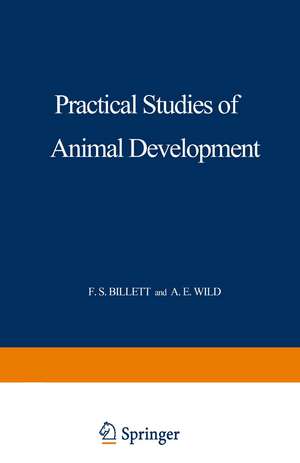Practical Studies of Animal Development
Autor F. S. Billetten Limba Engleză Paperback – 11 mar 2012
Preț: 384.31 lei
Nou
Puncte Express: 576
Preț estimativ în valută:
73.54€ • 76.63$ • 60.89£
73.54€ • 76.63$ • 60.89£
Carte tipărită la comandă
Livrare economică 03-17 aprilie
Preluare comenzi: 021 569.72.76
Specificații
ISBN-13: 9789401168861
ISBN-10: 9401168865
Pagini: 280
Ilustrații: XII, 252 p.
Dimensiuni: 140 x 216 x 15 mm
Greutate: 0.33 kg
Ediția:Softcover reprint of the original 1st ed. 1975
Editura: SPRINGER NETHERLANDS
Colecția Springer
Locul publicării:Dordrecht, Netherlands
ISBN-10: 9401168865
Pagini: 280
Ilustrații: XII, 252 p.
Dimensiuni: 140 x 216 x 15 mm
Greutate: 0.33 kg
Ediția:Softcover reprint of the original 1st ed. 1975
Editura: SPRINGER NETHERLANDS
Colecția Springer
Locul publicării:Dordrecht, Netherlands
Public țintă
ResearchCuprins
1 General Requirements.- Animals.- Legal considerations.- The laboratory.- Equipment.- Sources of information.- References.- 2 Echinoderms and Ascidians.- Echinoderms.- Ascidians.- References.- 3 Molluscs, Annelids and Nematodes.- Molluscs.- Annelids.- Nematodes.- References.- 4 Insects and Crustacea.- The Locust.- Calliphora.- Drosophila.- Crustacea.- References.- 5 Fish.- Goldfish.- Killifish.- Guppies.- Artificial fertilization.- Experimental Work on Fish Embryos.- References.- 6 Amphibia.- Xenopus.- Axolotls.- Experiments on Amphibian Embryos.- Experiments on amphibian larvae.- References.- 7 Birds.- Examination of the early chick blastoderm.- Culture of chick blastoderms.- Removal and culture of the blastoderm.- Preparation of chorio-allantoic grafts.- References.- 8 Mammals.- The oestrous cycle in the mouse.- Preparation of vaginal smears.- Examination of unfertilized ova from superovulated mice.- Reproductive system of the male mouse.- Examination of mouse embryos up to and including the blastocyst stage.- Arrangement of the foetal membranes in the rabbit and localization of immunoglobulin in the yolk sac splanchnopleur.- References.
